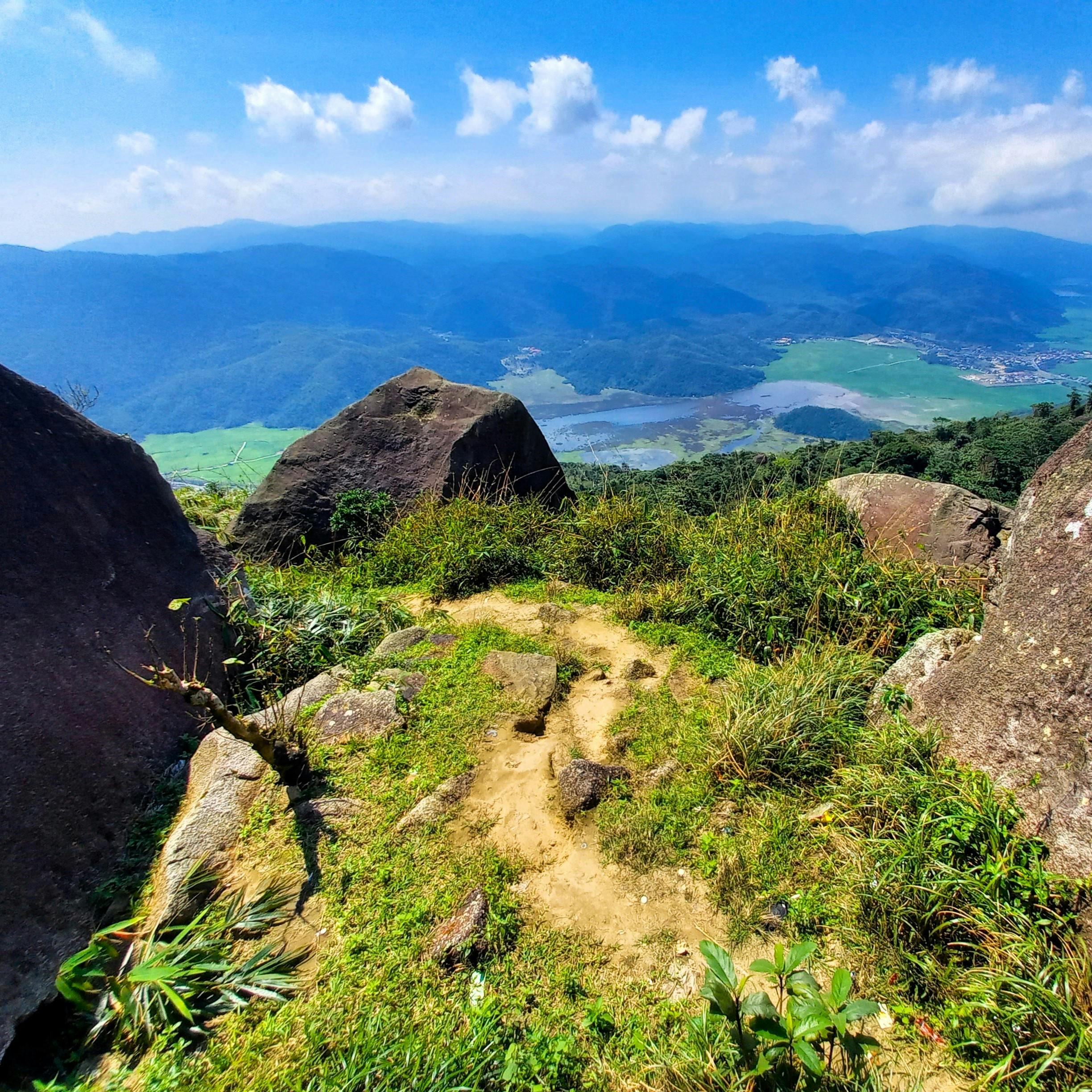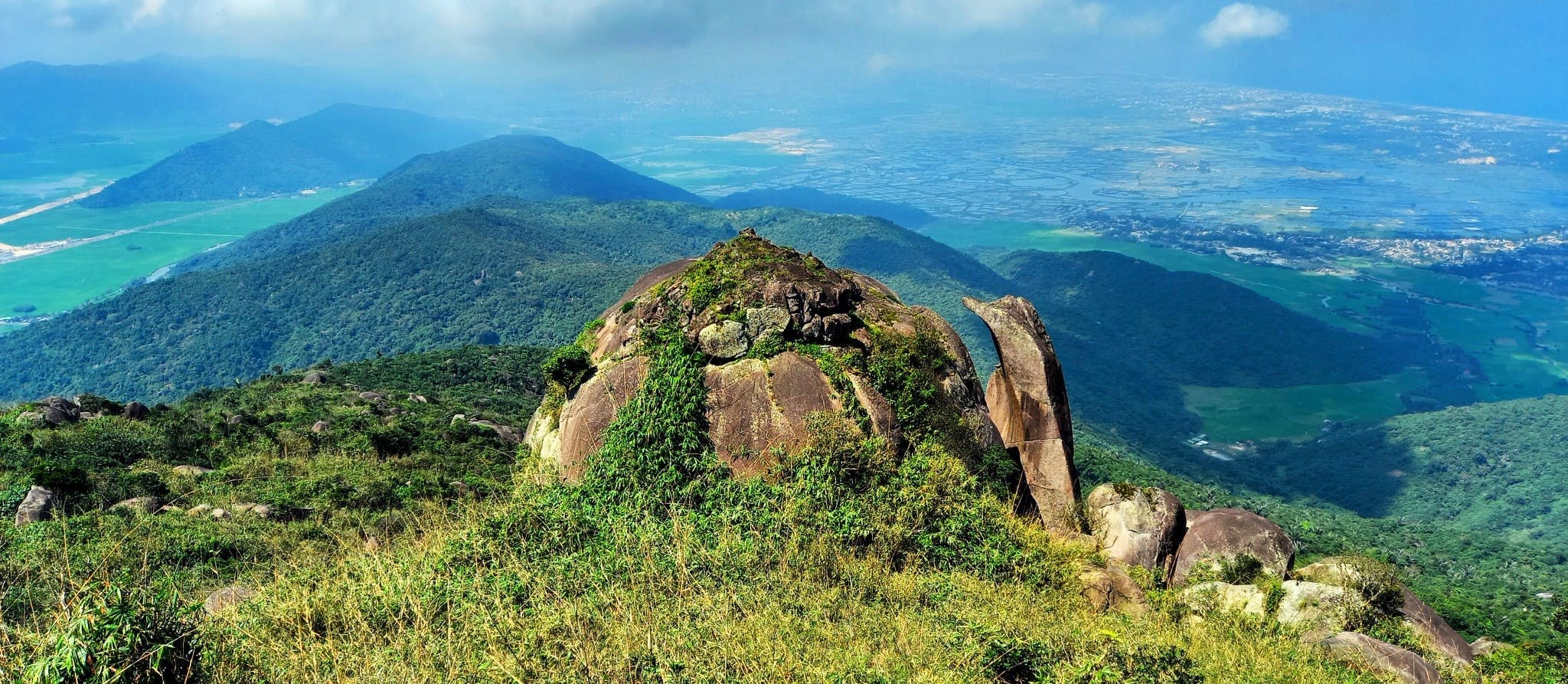First published February 2024 | Words and photos by Vietnam Coracle

Tom Divers is the founder and creator of Vietnam Coracle. He’s lived, travelled and worked in Vietnam since 2005. Born in London, he travelled from an early age, visiting over 40 countries (he first visited Vietnam in 1999). Now, whenever he has the opportunity to make a trip, he rarely looks beyond Vietnam’s borders and his trusty motorbike, Stavros. Read more about Tom on the About Page, Vietnam Times and ASE Podcast.
A steep ascent to a giant freestanding boulder at its peak, the hike up Núi Đá Bia offers mesmerizing views of the surrounding jungles, mountains and coast. Forming the provincial border at one of the most easterly points in the nation, Núi Đá Bia stands at 706m above sea-level in Phú Yên Province, south-central Vietnam. The extraordinary, 76 metre-high, naturally occurring slab of rock at its summit resembles a lone Easter Island statue commanding the highest point in the region. Known to the colonial French as the ‘Finger of God’, the boulder is shrouded in myth and legend. During the Kingdom of Champa, the peak was named Lingaparvata, the embodiment of the Hindu god Shiva. In 1471, Vietnamese emperor Lê Thánh Tông, passing beneath the mountain on his way south to commence battle with Champa, ordered an inscription carved at the base of the boulder stating his name and authority over all land south of the mountain. And so it came to pass. To this day, the mountain is known as Núi Đá Bia – ‘Stele Mountain’.

[Back Top]
NÚI ĐÁ BIA MOUNTAIN HIKE
A Steep Ascent to a Giant Boulder Summit with Mesmerizing Views
The climb starts halfway up the Cả Pass between Tuy Hòa city (25km north) and Đại Lãnh beach (10km south), both of which have accommodation. The trailhead is easy to find and the pathway to the summit is easy to follow. The hike is best undertaken as an interlude on a road trip along the coast or as a half-day excursion from one of the towns and beaches nearby or even Nha Trang (90km south). Although the trail is only about 2.2km and the climb is not at all technical, the hike can be quite strenuous and tiring because it is steep and relentless and conditions are often very humid and hot. Most of the trail is along stone steps of varying quality. I am relatively fit and the ascent took 1 hour; the descent was 40 minutes. I spent nearly an hour at the top admiring the views and exploring other small pathways. The roundtrip from trailhead to summit and back took about 2.5 hours. Most people should allow 2-3 hours to enjoy this hike, including stops. Hikers should bring plenty of water, a couple of small snacks, sunscreen and bug spray. There’s a small cafe at the trailhead where parking costs 10,000vnđ. This is a very satisfying hike with excellent views and there’s no one else around, although evidence of trash suggests that some people do attempt the climb occasionally. Any time of year is good, but the trail can be slippery in wet weather. Note that the markers on my map are accurate but the trail line is only approximate.

CONTENTS:

MAP:
Núi Đá Bia Mountain Hike
Support My Website
Please donate or become a patron if you enjoy my work. Vietnam Coracle is totally free & independent. I do not receive payment for anything I write.
Thank you, Tom
Núi Đá Bia Climb
Difficulty: moderately strenuous | Time: 2-3 hours | Entry: free | Guide: not necessary
[View Map]
At the apex of a switchback on the northern side of the Cả Pass, look for a sign next to a layby reading ‘Danh Thắng Núi Đá Bia‘. Here, there is a ramshackle cafe with roving goats where parking (10,000vnđ) for the hike is possible. The cafe has a few soft drinks, water and homemade rượu chuối rừng (wild banana liquor). Walk towards to the entrance gate and bear left up some stone steps leading to a war monument commemorating Vietnamese victories here against the colonial French in 1947 and 1954. On one side of the monument there’s a rather beautiful poem by Hữu Loan about the pass, the battle and the mountain. Descend the stairs from the war memorial and walk through the entrance gate where there’s a large white-painted stone marker on your right indicating the start of the hiking trail. On the back of the marker, there’s information about Núi Đá Bia Mountain (in Vietnamese only) which relates most of what I’ve mentioned in the introduction at the top of this guide.




The trail immediately heads into the jungle via a concrete bridge and stone stairs. From here all the way to the summit it’s mostly a steep ascent on stone steps, stairways and boulders. From the trailhead, the giant boulder on the summit is visible, but once you begin on the trail, you won’t see the boulder again until you’re just a few metres below it at the peak. The jungle is dense and very green – wild tigers were living here at least until the middle of the 20th century. The forest floor is strewn with fallen leaves and branches, interspersed with large rocks and smooth grey-blue boulders. The steepest sections are traversed by short stairways that break the jungle canopy. Other sections involve negotiating grooves carved into the boulders or rough brick and rock steps beneath thick foliage. At times, there are handrails to help take the pressure off your knees.





At the lower end of the climb, the road and railway weaving along the Cả Pass hundreds of metres below can still be heard. But as you climb higher, the only sounds are bird calls and the wind rustling leaves in the treetops. The smells of the jungle are potent: damp earth, fragrant flowers and decomposing tree trunks and animals. The hike is physical because of the need to keep stepping up constantly. It is also very humid in the jungle causing a lot of perspiration. There are several opportunities for short water breaks where the jungle opens up allowing unbroken views across the exceptionally green landscape below. The valley floor is carpeted with rice paddies and the slopes are covered in tropical trees.




As you climb higher on the trail, the jungle thins, the air temperature drops slightly and a light breeze filters through the trees. Suddenly, a massive grey shadow looms above the path. The summit boulder bears down on the final steep stairway to the peak. It’s a dramatic sight. Looking up a the boulder standing all alone with nothing but the sky behind it can be mildly vertigo-inducing; looking down into the valley and the sparkling sea below is thrilling. Clamber over the last few rocks and you will arrive at the summit in the shadow of the boulder on ‘Stele Peak’ with astonishing panoramic views.






Nothing prepares you for the scale of the boulder at the summit: it is enormous. A giant 76 metre-high slab of sheer rock pointing to the sky with a smooth concave curve on its southern flank. I’m not a free solo climber, but if I were, I’d be very excited about the prospect of scaling the rock via the crack that leads straight up to the top. There’s a small Buddhist and Christian altar on the west side of the boulder (and a fair amount of graffiti too). It’s possible to circumnavigate the boulder, but be extremely careful on the eastern edge where one slip would result in a catastrophic fall. There are also little pathways (mostly hidden by thick brush) leading to other smaller peaks to the north of the boulder, which afford utterly sensational views of the rock and the surrounding landscape and ocean. Take your time exploring and enjoying the summit before undertaking the descent.
Gravity will take care of your progress during the descent – indeed, it is difficult to stop the downwards momentum. Once back at the parking lot at the trailhead, take advantage of the free vehicle washing service at the cafe, which channels fresh water from streams on the mountain into hosepipes – ideal for a refreshing (and much needed) shower.





*Disclosure: I never receive payment for anything I write: my content is always free and independent. I’ve written this guide because I want to: I like this climb and I want my readers to know about it. For more details, see my Disclosure & Disclaimer statements and my About Page


